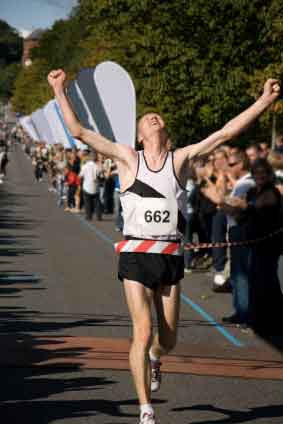Archive for Running Tips
Springbak Running Tips – Lactate Threshold and Endurance Training
Posted by: | CommentsResearch and World Class Runners say:
Lactate is produced as a side reaction in a metabolic process called glycolosis. Glycolosis is the body’s energy system that breaks down carbohydrates (glucose) that are stored in muscle and liver to produce energy. Lactate IS NOT the cause of acidosis-that burning sensation we all feel in our muscle-but rather it is the byproduct of glucose breakdown during intense exercise. So lactate is actually an indirect measure of acidosis or muscle fatigue.
Your Lactate Threshold (LT) is a marker showing how much exercise (or physical work) you can sustain before the evidences of glycolosis are present. More importantly LT is that point in your exercise level where you begin to accumulate lactate in the blood and breathing becomes noticeably more labored (ventilatory changes). Your LT usually corresponds to your best 15K or 10 mile running pace or a 40K running time trial on a road bike.
Your LT can be evaluated by several methods that include monitoring your heart rate, oxygen consumption and Power output or speed at LT. With appropriate training technique you can increase your LT which will enhance your body’s ability to increase energy production through mitochondrial respirations (or more aerobic pathways) thus decreasing the reliance on energy from glycosis (anerobic). Which means you can spare your glycogen(your bodies stores carbohydrates) which are in limited supply compared to the large amount of energy you have available from fat storage.
Additionally, smart endurance training will improve your acidosis-buffering effect, thereby decreasing fatigue allowing for a longer tolerance of challenging workouts and an enhanced training effect allowing for even more intense training. Here are some recommendations from world class athletes and trainers that use Springbak Springsoles in their training programs on how to improve your Lactate Threshold.
1) An intense workout that is slightly above your LT is considered by most researchers and runners to be the best method for boosting LT.
2) 20 minutes or more of training at a heart rate just above the LT is enough to increase LT.
3) Lactate Threshold tends to be higher in older runners with one study showing the average LT at 85% of MaxVO2 for younger. Keep in mind that MaxVO2 scores are lower in the older athletes since they tend to decline with age.
4) Research suggests that training programs that are a combination of high volume, interval and steady-state workouts have the most pronounced effect on lactate threshold improvement.
Enjoy the running tips and have fun!
Mark Vona – GM Springbak Inc.
—
For more tips and information:
Visit the Official Springbak® Website at www.springbak.net
Peak Performance Springsoles / Insoles – Run Faster, Jump Higher, Lessen Fatigue
Marathon Running Tips: by Brendan Brazier – World Class Ironman Triathlete
Posted by: | CommentsWhy Endurance Athletes Need Strength:
Clearly marathon running is an endurance event, and not necessarily a strength sport. But for a marathoner, the ability to lift more weight offers a significant advantage and benefit.
For example, if two runners are equal in every respect except for muscular strength, the stronger athlete will be faster over any distance. If one runner can squat 10% more weight than another, his muscles will not have to work as hard to move the body forward, maximizing his endurance gains. And when muscles don’t need to work as hard, they also don’t require as much oxygen or circulating blood, putting less demand on the heart, lowering one’s heart rate and improving endurance significantly. Greater strength equals greater endurance!
What Body Parts to Train:
While you would expect the focus for runners and cyclists to be the legs, muscle gains and upper-body strength can offer a significant performance advantage.
Using your arms and upper body improves the muscle function in those areas. Each time muscles contract, oxygen levels and nutrients in the blood are needed. As with the legs, your arms will draw upon the heart to deliver oxygen and nutrition and remove waste products (lactate) so that they can continue moving fluently. Therefore, it makes sense to increase your upper-body strength as well so that it doesn’t become too much of an oxygen draw on your system and increase your heart rate.
Training Fuel:
Nutrition is a vital part of physical training. Of course, what you eat becomes the building blocks used to reconstruct the muscle tissue that your training has broken down. Make sure to consume a nutrient-packed smoothie after each workout. Quick and efficient recovery from each workout is key. The faster you can recover, the sooner you can train again. This is what leads to true gains and will improve your performance more than any other single principal. Visit Brendan’s site at www.brendanbrazier.com
______________________
For more tips and information:
Visit the Official Springbak® Website at www.springbak.net
Peak Performance Springsoles / Insoles – Run Faster, Jump Higher, Lessen Fatigue
Triathlon Training Trips – Ironman Triathlete Brendan Brazier’s Top Training Pointers
Posted by: | Comments 1) Positive Attitude: Enthusiasm and enjoyment of the sport is necessary for success. “I run because I enjoy it. It’s that simple. I believe my success as an athlete is directly related to my love of the sport. Since I perceive it as stress-relieving, it is. For me, there’s no better way to mentally de-stress than going for a long bike ride or run.
1) Positive Attitude: Enthusiasm and enjoyment of the sport is necessary for success. “I run because I enjoy it. It’s that simple. I believe my success as an athlete is directly related to my love of the sport. Since I perceive it as stress-relieving, it is. For me, there’s no better way to mentally de-stress than going for a long bike ride or run.
2) Don’t GO Buck Wild: Pace yourself. Enthusiasm is great but it often overflows at the beginning, leading to over-training and most likely injuries or at the very least, general fatigue. It takes years to build up the aerobic engine, so patients are a virtue. The number one reason for injury is building up mileage too quickly. Increasing mileage by no more than 10% weekly is a good way to prevent injuries. Provided an athlete’s diet is good and they stay injury free, most endurance athletes peak in their mid-30’s.
3) Increase Your Intake of Raw Fruits and Vegetables: For optimal hydration, replace dry, cooked and processed foods with fresh fruits and vegetables. Most raw foodies don’t need to consume as much water as those on a standard diet. The shift toward more raw foods will certainly help maintain hydration, and might even improve your overall health.
4) Eat Your Electrolytes: Dulce, available in most health food stores, is an easily digestible seaweed that’s rich in electrolytes, chlorophyll and B vitamins. Munch it throughout the day to ensure the electrolytes lost during workouts get replaced. Electrolytes regulate the smooth and efficient contraction of muscles.
5) Focus on Abs: I train abs five times a week because a strong midsection helps prevent low back injuries and increases running efficiency.
Tips Provided By Brendan Frazier – World Class Ironman Athlete
“I’m very pleased with the insoles. They’re certainly living up to the expectations I had for them after reading through the Springbak.net website. I’m feeling strong, but it’s not just strength, it’s stable strength that can be transferred to the ground efficiently – moving me forward while conserving energy. Towards the end of a longer run I still feel fresh, and able to maintain a quick and efficient stride.”
Brendan Brazier – World Class Ironman Athlete on Springbak Springsoles / Insoles
____________________
For more tips like these:
Visit the Official Springbak® Website at www.springbak.net
Performance Boosting Springsoles / Insoles – Run Faster, Jump Higher, Lessen Fatigue
Triathlon Training Tips – Proper Hydration
Posted by: | Comments
Brendan Brazier - World Class Ironman Athlete
By Brendan Brazier – World Class Ironman Tri-Athlete
“Most athletes, whether professional or those of the weekend variety, understand that drinking sufficient water is an important element of health and performance, but few understand how to properly achieve true hydration.
Today’s the day, you’ve entered your very first race. To prepare, you got a good nights sleep, munched a power bar for breakfast, and now you’re slugging back a sports drink for hydration.
As the race begins, you feel great, your hitting your stride. But what happens next is unexpected: your cadence begins to slow while your heart rate quickens. Your movements are no longer fluid, but angular and mechanical. Breathing becomes labored, and the twitching in your calves spreads to the hamstrings and quadriceps. Dehydration has set in, and no amount of fluid at this point can save your race. The damage is done. What can be done here?
Balance your water intake:
Dehydration occurs when the body sweats out more fluid than it takes in, and one of the first physiological responses is the thickening of the blood, which creates more work for the heart. The added stress on the heart from dehydration significantly decreases endurance. Over-hydration, on the other hand, occurs when more water is consumed than the body can process.
Hyponatremia is the point at which the body becomes over-hydrated. Too much water flushes minerals, known as electrolytes from the body. These minerals help regulate the smooth and efficient contraction of muscles, and when the body’s electrolyte levels become too low, cramping, muscle spasms and other signs comparable to dehydration occur.
Don’t make the mistake many athletes have made by drinking copious amounts of water in the days prior to your running competition day. Instead, consume only a moderate amount of water, sipping it throughout the day, and avoid all caffeinated drinks, since caffeine is a diuretic. Limit high-protein foods prior to any endurance event, since water is “sucked up” during the digestive process. Fresh fruit is the best option!”
____________________
For more tips like these:
Visit the Official Springbak® Website at www.springbak.net
Performance Boosting Springsoles / Insoles – Run Faster, Jump Higher, Lessen Fatigue
One of the biggest deterrents for beginner runners in not knowing how to breath properly. If you are just starting out in the sport of running you will know how discouraging it feels to be out of breath after exercising for a fairly short amount of time. So what’s the solution? First of all it helps to understand why we start breathing hard after exerting ourselves.
Why we get out of breath
If non-scientific terms we are simply using up more oxygen to perform an exercise that we are supplying through our breathing. When you first start running you don’t notice your breathing(depending on how fast you go), but after a while you’ll start to feel out of breath. This point of needing more oxygen is called our anaerobic threshold.
How Training Helps
If you are just beginning an exercise program, your anaerobic level will be quite low, compared to that of a more experienced athlete. Your goal is to gradually increase that level through training until you can run long distances comfortably without getting out of breath. People who run marathons are a great example of this, their bodies tire out long before thay are ever out of breath. As a beginner runner you have to focus on increasing your anaerobic threshold without being discouraged before you get there. Don’t go out with more experienced runners, you’ll be really struggling to try and keep up. Don’t try to run every day either, your body needs time to recover.
Run – Walk Combination
It’s best to start with a run-walk routine. A good place to start is with a 3-4 minute slow jog, followed by a 3-4 minute walk. Every other day or so, gradually increase the running time while decreasing the walking time until you reach 12 minutes running to 3 minutes walking. At this point you shopuld notice a marked difference in your ability to run without getting out of breath. If you still are a little breathless, chances are you are running too fast. Slow down!
You should soon reach the stage where you can run 20-30 minutes without needing a break. Your anaerobic threshold in increasing! How long will this take? Depending on your current fitness level, age, weight, ect. it could be anywhere from 2 weeks to two months to reach this point. Don’t give up, it will happen and you will be proud it has, you have earned it!
Nose or Mouth?
Many people ask whether you should breath through your nose or mouth whan you are running. As you start out you will be trying to get as much oxygen as possible and most people at this level breath with both their nose and mouth. As you get fitter you’ll find that you will naturally inhale mostly through your nose and exhale through your mouth.
Deep Breathing?
Don’t try to breath too deeply as you run or you’ll run out of oxygen. Ther’s a general rule of thumb that says you should be able to carry on a conversation while you are running. Again, as you get in better shape this will happen naturally.
Conclusion
Your fitness level and breathing pattern are closely related. It takes time before you’ll be able to run consistently without getting out of breath. Simple be patient and monitor your progress, keep a log of your progress and have fun!
____________________
Visit the Official Springbak® Website at www.springbak.net
Performance Boosting Springsoles / Insoles – Run Faster, Jump Higher, Lessen Fatigue






















